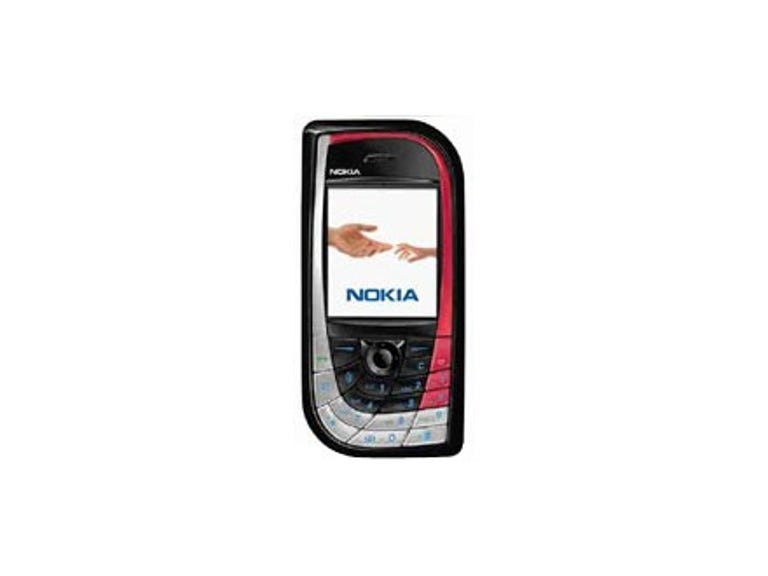 Why You Can Trust CNET
Why You Can Trust CNET Nokia 7610 review: Nokia 7610
Nokia's first megapixel camera phone runs on the Symbian operating system, has a unique design and a pack of smart phone features such an Internet browser and a video player.
Nokia has gone with a slightly unconventional design on the 7610. Its keypad is laid out irregularly in a sweeping fashion with keys flush against each other having different sizes and shapes. The outer case is easily removed so changing covers should be no problem. Our test handset came in a white case with grey and mirrored elements on the back.
Wide and short dimensions give the 7610 a blockish appearance which Nokia has offset by curving two opposing corners, similar to the style of the 3G-enabled 7600. All up, its 118g weight is evenly distributed throughout the phone, which measures 109 x 53 x 19mm.
The Good
The Bad
The Bottom Line
The 7610's display is a large and bright TFT screen (65,536 colours; 176 x 206 pixels) which is one of the most impressive screens we've seen on a Nokia handset to date. A decent screen is pretty much a necessity for a mobile phone that includes a one megapixel camera, such as this.
Features
As the 7610 runs on Symbian's operating system, users familiar with standard Nokia handsets might initially experience a degree of difficulty swapping over to an unfamiliar interface. The menu structure is somewhat similar to other Nokia phones (contacts, messaging, gallery, etc) but the main menu is icon-based, which scrolls through the many available functions.
One of these applications is Real player, included to play back MP3 and AAC music files as well as 3GPP and RealMedia files. 8MB of internal memory is onboard with support for external memory through a Reduced Size MultiMediaCard (RS-MMC) slot. Like Nokia's original N-Gage, to insert the MMC you need to remove the back cover as well as the battery, so you can't change cards on-the-fly. Nokia bundles a 64MB card in the package that can be used to store contacts, messages, photos, music, applications and other files.
Videos up to ten minutes in length can be taken at a resolution of 128 x 96 pixels or 176 x 144 pixels. Photos can be captured in three resolution setting, the maximum using one megapixel. Through the Gallery application, you can browse image, sound, and video directories on the phone's memory or on the memory card.
Nokia has added a couple of fun video editing tools so you can play around with the movies you take. Movie Director is an application that automatically converts videos by adding a theme, overlays and an accompanying sound clip. For instance, if you choose to make a "paparazzi" movie, the 7610 adds camera flashes, overlays of lenses and a stalking soundtrack to your clip. It's a cute feature that can quickly spice up videos to send to friends via MMS.
An interesting diary-like application included on the Nokia 7610 is Lifeblog. It combines text messages, multimedia messages, photos, and video so you can browse them chronologically in a timeline. By downloading the complimentary PC version of the software, you can synchronise these elements with your desktop and send them via e-mail.
The Opera Web browser is also onboard and with the help of the Noweigian company's Small-Screen Rendering technology, the browser reformats Web pages to fit nicely inside the 7610's display.
It's always handy when a mobile phone comes with a USB cable even when it has Bluetooth. The thoughtful inclusion from Nokia allows you to synchronise elements such as Outlook contact and calendar, transfer files and photos, plus backup the contents of your phone using Nokia PC Suite (which comes bundled on a CD).
Travellers should note the 7610 provides tri-band coverage to keep you connected when you are roaming internationally.
Performance
Battery life on the 7610 varies greatly depending on what features you use. With average usage we found the handset to last between three to four days. Expect a bit less than this if you're going to be using the camera for stills / video a lot, or if you plan on watching video clips constantly. Nokia states a maximum talk time of three hours and standby time of up to ten days.
The Nokia 7610 is the first handset from the Finnish phone manufacturer to include a one-megapixel camera. The next in the company's megapixel line-up on the cards is the 6630 Smartphone -- a 3G handset.


